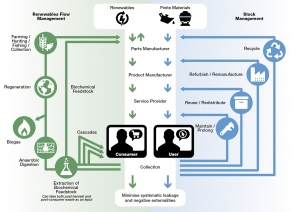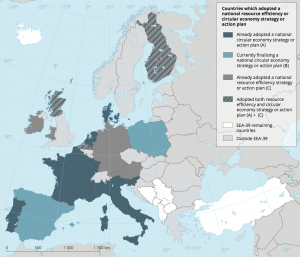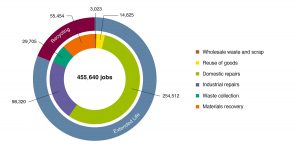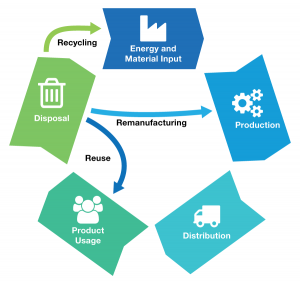8.3 Circular Economy
Learning Objective
2. Explain the concept of Circular Economy.
The European Union, the national government of many countries and businesses worldwide, promoted the concept of the so-called Circular Economy (CE) (Korhonen, Honkasalo & Seppälä, 2018). According to the European Commission, 600 billion euros can gain the manufacturing sector alone for the EU after the transition to the circular economy-type economy. Only the national Finland economy can earn 2.5 billion euros through a circular economy, and the global economy estimated benefits by 1000 billion US dollars annually (Korhonen, Honkasalo & Seppälä, 2018). It’s interesting to say that the first country was China, which adopted the circular economy in 2008 because it was recommended for economic growth and part of the country’s sustainable environmental and economic development (Korhonen, Honkasalo & Seppälä, 2018).
With the dawn of industrialization, the circular economy is a great practice to minimize the negative impact on the environment and simultaneously stimulate businesses to find new opportunities (Korhonen, Honkasalo & Seppälä, 2018). A circular economy implies the following solutions to reduce adverse environmental effects: remanufacturing, repair, reuse, refurbishment, disposal, cascading, upgrading, and recycling. Please see figure 8.3 below. Authors of the academic journal “Circular Economy: The Concept and its Limitations” (2018) have given the current concept of circular economy with inner circles of product reuse, recycling, disposal, remanufacturing. Those inner circles demand less energy, fewer resources, and it is more economical than the standard recycling of goods. It is essential to know that the time within circles must be maximized (Korhonen, Honkasalo & Seppälä, 2018). According to the CE, the latest material should be landfill disposal, and the last option has been combustion for energy (Korhonen, Honkasalo & Seppälä, 2018). Authors have mentioned that the product’s life cycle and its value should retain the highest possible quality/value as long as possible (Korhonen, Honkasalo & Seppälä, 2018). The Circular Economy concept is popular nowadays because it extends the utilization of typical waste of materials by utilizing the value embedded in products.
Figure 8.3
The Current Concept of Circular Economy
Note. Adapted from Korhonen, Honkasalo, & Seppälä, 2018. [Image description].
The circular economy is the win-win-win potential for sustainable development because the CE contributes to sustainable development’s economic, social, and environmental dimensions (Korhonen, Honkasalo & Seppälä, 2018). Read more about the Circular Economy.
Let’s look into the statistics below and interesting diagrams that clearly explain the Circular Economic system diagram concept, European countries with a circular economy strategy, job breakdown by pillar and sector in 2017 in terms of the number of people employed.
Consider This: Circular Economic (CE) Systems Statistics and Visuals
The following material is adapted from Field Actions Science Reports, 23, 4-7 by Circular Economy: Strategies and Policies (2021) under a Creative Commons Attribution License 4.0.
Circular Economy System Diagram

The diagram illustrates different strategies for looping material and energy flows to reduce resource extraction (top half) and avoid waste creation (bottom half). Two types of circularity strategies are depicted: for technical inputs from non-renewable resources (right-hand side) and for biochemical inputs from renewable resources (left-hand side). In principle, the shorter the loop (e.g.: maintenance, reuse), the greater the likelihood of maintaining economic value and minimizing environmental impacts (Circular economy: strategies and policies, 2021).
Figure 8.5
European Countries with a Circular Economy Strategy

This map, taken from a European Environment Agency study, shows countries which had adopted a national resource efficiency or circular economy strategy or action plan as of 2019. The colour legend indicates the state of progress with these measures. The map does not show countries that have simply indicated an intention to take action in the future. In total, 21 of the 32 countries in the study stated they had begun work on drafting national policies relating to the circular economy (Circular economy: strategies and policies, 2021).
Job Breakdown by Pillar and Sector in 2017 in Terms of the Number of People Employed

This is one of eleven indicators used to track circularity in the French economy. It seeks to quantify the number of jobs associated with economic activities within the circular economy. Only activities relating to “extended life” and “recycling” are studied here, i.e. reuse and repair of goods, waste collection and materials recovery. These activities create more jobs per unit managed than activities relating to waste disposal (landfill and incineration).(Circular economy: strategies and policies, 2021) CC-BY-4.0
Check Your Understanding: Explain the concept of Circular Economy
Answer the question(s) below to see how well you understand the topics covered above. You can retake it an unlimited number of times.
Use this quiz to check your understanding and decide whether to (1) study the previous section further or (2) move on to the next section.
Interactive activity unavailable in this format
Text-based alternative to interactive activity available in Chapter 8.8.
Overall Activity Feedback
According to the European Commission, 600 billion euros can gain the manufacturing sector alone for the EU after the transition to the circular economy-type economy. Only the national Finland economy can earn 2.5 billion euros through a circular economy, and the global economy estimated benefits by 1000 billion US dollars annually. With the dawn of industrialization, the circular economy is a great practice to minimize the negative impact on the environment and simultaneously stimulate businesses to find new opportunities. A circular economy implies the following solutions to reduce adverse environmental effects: remanufacturing, repair, reuse, refurbishment, disposal, cascading, upgrading, and recycling. The circular economy is the win-win-win potential for sustainable development because the CE contributes to sustainable development’s economic, social, and environmental dimensions.
Media Attributions and References
Circular Economy: Strategies and Policies. (2021, December 9). Field action science reports (23), 4-7. Institut Veolia. https://journals.openedition.org/factsreports/pdf/6515
Korhonen, J., Honkasalo, A., & Seppälä, J. (2018). Circular economy: The concept and its limitations. Ecological Economics (143), 37–46. https://doi.org/10.1016/j.ecolecon.2017.06.041


